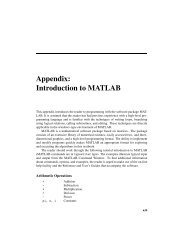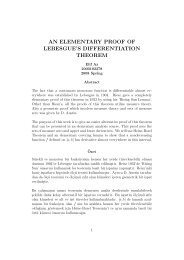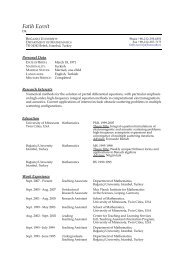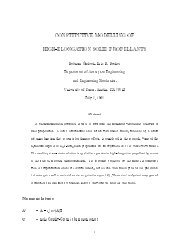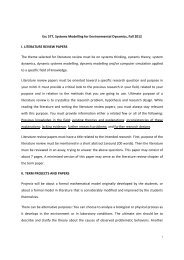CONSTITUTIVE EQUATIONS FOR SOLID PROPELLANTS
CONSTITUTIVE EQUATIONS FOR SOLID PROPELLANTS
CONSTITUTIVE EQUATIONS FOR SOLID PROPELLANTS
Create successful ePaper yourself
Turn your PDF publications into a flip-book with our unique Google optimized e-Paper software.
Cyclic Eect<br />
In order to represent cyclic eects, i. e. the rapid decrease of stress during unloading, the large<br />
amount ofhysteresis in load/unload cycles, and the dependence of response on the maximum strain<br />
previously attained, we introduce another internal state variable as an argument ofd and postulate<br />
the form<br />
d(s i )=g(s 1 )f(s 2 ) (12)<br />
where g is the damage function with argument s 1 = c max as introduced above. The function f<br />
represents the eect of cyclic loading and is allowed to dier for the situations of unloading and<br />
reloading.<br />
A reasonable choice for the argument of function f representing the joining of the reloading<br />
curve to the original loading curve beyond the previous maximum strain is<br />
s 2 =<br />
I <br />
I max<br />
(13)<br />
where I max<br />
represents the maximum I previously achieved during the loading history. During<br />
loading s 2 is unity. Its value decreases during unloading, and increases during reloading. For<br />
the latter we allow s 2 > 1, since we consider a given state as reloading until it rejoins the original<br />
loading curve. In this manner we account for the fact that reloading curve joins the original loading<br />
curve gradually.<br />
In order to implement the eect of cyclic loading into the model we apply the following criterion<br />
to distinguish between rst loading, on the one hand, and unloading/reloading, on the other<br />
_c(t) < 0 unloading ) _ f = _ f u<br />
_c(t) 0 and f(t) < 1 reloading ) _ f = _ f r<br />
_c(t) 0 and f(t) =1 loading ) _ f =0 (14)<br />
10



